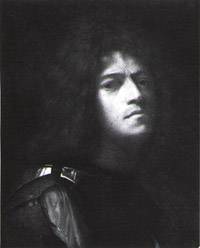
The
career of Giorgio Barbarella, known as GIORGIONE, streaked across
the artistic firmament of Venice with the intense brilliance and
all of the mystery of a powerful comet. Few of his works survive,
but by the time of his early death from the plague in 1510 Giorgione
had, in the words of Umberto Fortis (The Uffizi: A Guide to the
Gallery [Venice: Edizione Storti, 1980], p. 60), "determined
a decisive change in the painting not only of the Veneto but of
Europe."
As explained by Fortis (p. 63), "Giorgione's innovation, so-called
'tonal painting,' is characterized principally by the creation of
images through color alone, without the linear structure of Tuscan
tradition. Through the modulation of light in tonal gradation as
a means of placing the human figure in the landscape, Giorgione
effectively realized a wholly new vision, a more intimate link between
man and nature."
The earliest surviving notice of Giorgione's career is a writing
dated June 1506 which identifies him as a colleague of the painter
Vincenzo Catena at that time. In August of the following year the
Council of Ten committed to pay Giorgione for a painting for the
Sala Andentina in the Doge's Palace. In 1508, assisted by Titian,
he was at work applying exterior frescoes to the Fondaco dei Tedeschi.
Among the surviving paintings that are attributed to him with reasonable
authority, La Vecchia [The Old Woman] and La Tempesta
[The Tempest] (c. 1503-5) are on display at the Accademia Museum
in Venice. His Madonna and Child with St. Francis and S. Liberale
(c. 1505), commissioned by the condottiere Tuzio Costanzo,
is in the right aisle of the Cathedral [duomo] of Giorgione's
home town, Castelfranco Veneto. Other generally accepted attributions
include Judith (c. 1504-5) at the Hermitage in St. Petersburg,
Three Magi (c. 1506) at the Kunsthistorisches Museum in Vienna
and Sleeping Venus (c. 1507-8) at the Gallery in Dresden.
Giorgione is also contemporaneously reported to have painted a portrait,
now lost, of Queen Caterina Cornaro (B-31)
on horseback. (Less credibly, a half-length portrait of the Queen
that was formerly in the collection of Sir Herbert Cook of Richmond,
England, is sometimes attributed to Giorgione as well.)
Shown above is a detail from Giorgione's Self Portrait as David
with the Head of Goliath, now in the Herzog Anton-Ulrich Museum
in Braunschweig.

